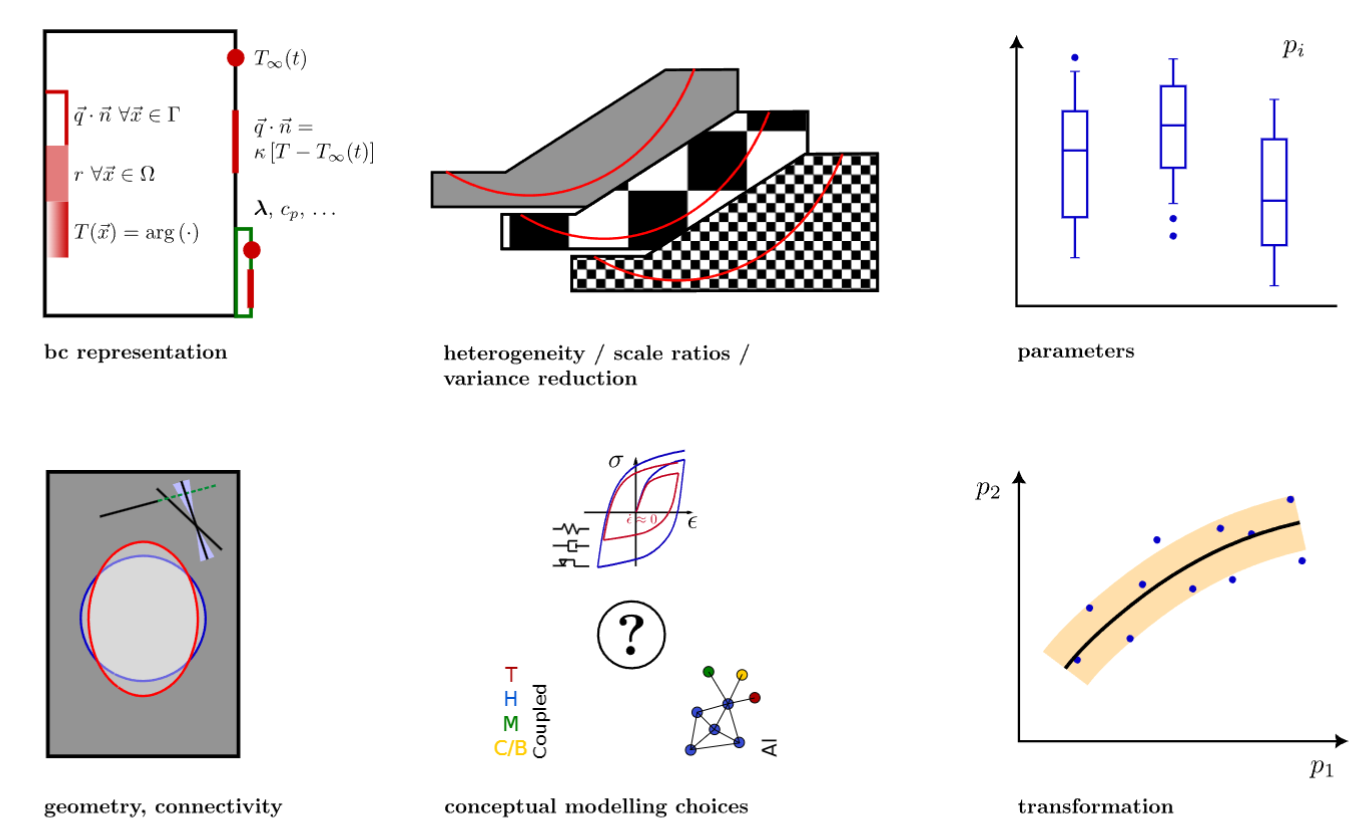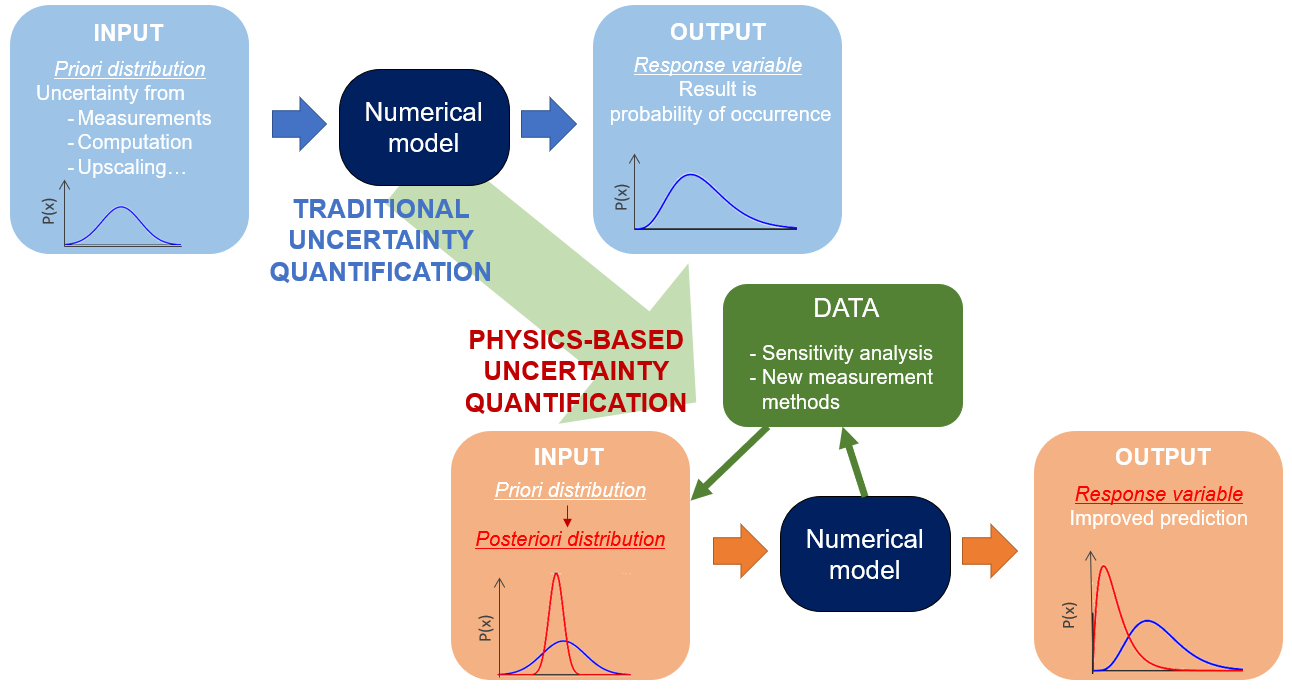¶ Methods for the quantification of uncertainty and robustness
The study of uncertainty quantification (UQ) methods and the robustness of conclusions drawn from thermo-hydro-mechanical-chemical (THMC) models are essential elements in the long-term assessment of radioactive waste repositories. THMC models enable the simulation of the different processes occurring within and in the vicinity of the repository during the assessment period. This, in return, allows a better understanding of the system behavior and allows for quantitative assessment of the barrier integrity, leading to well-informed statements regarding the long-term safety of the repository system.

Viewing simulation results obtained during such safety investigations in a probabilistic way as a consequence of the existing data, parameter, model and scenario uncertainties is expected to lead to more meaningful quantitative expressions of integrity (Lehmann et al. 2024). The aim of such an approach is to avoid common pitfalls of classical analyses which may yield non-conservative results or only insufficiently covered parameter space.
The present subproject is intended to develop and test methods for probabilistically sound (geological) barrier-integrity assessment that are based on modern mathematical methods of uncertainty quantification. Mathematical modeling – tailored to the used THM models and measured parameter distributions – from the fields of probability calculation, statistics, numerical mathematics and data sciences enables an innovative, largely automated approach to quantify the propagation of uncertainties and the problem-specific engineering characteristics.
¶ Methodology
The project goals relate to the integration of workflows, methods and instruments for experimental-numerical analysis of parameter uncertainties with respect to the safety analysis of potential repository sites in a numerical environment (OpenGeoSys). To realize and demonstrate the project goals, the following workflow is proposed using the above mentioned mathematical framework:

1. Initial assessment of parameter variability with little site-specific information:
Uncertainty quantification of parameter sets related to typical THMC analyses (Buchwald et al. 2020; Chaudhry et al. 2021) and the attribution of this parameter variability to different physical origins, e.g., spatial variability in statistically homogeneous geological units; random and systematic measurement errors; transformation errors (Gräsle and Plischke, 2010). The purpose of the initial assessment is to determine how the model parameters can be restricted to physically meaningful parameter sets. The main contributors here are teams from the Chair of Numerical Analysis at TU Chemnitz, the Federal Institute for Geosciences and Natural Resources, and the Geotechnical Institute at TU Bergakademie Freiberg.
2. Improved characterization with site-specific information at tunnel scale:
Demonstration of the developed mathematical methods and calibration techniques using experimental data from an underground research laboratory (Mont-Terri) experiment. Sensitivity analyses are used to reveal parameters dominating uncertainties and to improve monitoring/characterization methods (Seyedi et al. 2021; Pitz et al. 2023a ; Pitz et al. 2023b). The principal teams working on this task are from the Geotechnical Institute at TU Bergakademie Freiberg and the Department of Environmental Informatics from the Helmholtz Center for Environmental Research (UFZ).
3. Application at repository scale:
Feasibility study on the proposed analysis method for geological barrier integrity based on statistically characterized input data and probabilistically formulated integrity criteria (Gates and Bittens, 2015; Bittens and Gates, 2023). This task is primarily performed by the Federal Institute for Geosciences and Natural Resources.
The main outcome of this project is to propose methods and demonstrate their feasibility for propagating parameter uncertainty through THM model-based integrity analysis with a particular focus on questions related to:
- how scale affects the parametrization;
- how the integrity criteria can be transferred to a probabilistic context;
- and finally, how efficient numerical mathematics can be used in all stages of this workflow.
Additionally, the planned illustration of simulation results with uncertainties in the context of virtual realities represents a significant asset for an improved communication of the difficult topic of “uncertainties in safety assessment”.
¶ References
- L. Bilke, T. Fischer, D. Naumov, C. Lehmann, W. Wang, R. Lu, B. Meng, K. Rink, N. Grunwald, C. Silbermann, R. Habel, L. Günther, M. Mollaali, T. Meisel, J. Randow, S. Einspänner, H. Shao, K. Kurgyis, O. Kolditz, J. Garibay (2022). OpenGeoSys. Zenodo. DOI:10.5281/zenodo.7092676
- M. R. Bittens and R. L. Gates (2023). DistributedSparseGrids.jl: A Julia library implementing an Adaptive Sparse Grid collocation method. Journal of Open Source Software, 8(83). DOI:10.21105/joss.05003
- J. Buchwald, A. A. Chaudhry, K. Yoshioka, O. Kolditz, S. Attinger, and N. T.(2020). DoE-based history matching for probabilistic uncertainty quantification of thermo-hydro-mechanical processes around heat sources in clay rocks. International Journal of Rock Mechanics and Mining Sciences, 134. DOI:10.1016/j.ijrmms.2020.104481
- A. A. Chaudhry, J. Buchwald, and N. T. (2021). Local and global spatio-temporal sensitivity analysis of thermal consolidation around a point heat source. International Journal of Rock Mechanics and Mining Sciences, 139. DOI:10.1016/j.ijrmms.2021.104662
- R. L. Gates and M. R. Bittens (2015). A multilevel adaptive sparse grid stochastic collocation approach to the non-smooth forward propagation of uncertainty in discretized problems. arXiv Preprint. DOI:10.48550/arXiv.1509.01462
- W. Gräsle and I. Plischke (2010). Technical Report 2009-07: LT Experiment - Mechanical behavior of Opalinus Clay, Final report from Phases 6 - 14. Technical report, Bundesanstalt für Geowissenschaften und Rohstoffe
- C. Lehmann, L. Bilke, J. Buchwald, N. Graebling, N. Grunwald, J. Heinze, T. Meisel, R. Lu, D. Naumov, K. Rink, O. Özgür Sen, P. Selzer, H. Shao, W. Wang, F. Zill, T. Nagel and O. Kolditz (2024). OpenWorkFlow - Development of an open-source synthesis-platform for safety investigations in the site selection process. Grundwasser - Zeitschrift der Fachsektion Hydrogeologie, 29, 31-47. DOI:10.1007/s00767-024-00566-9
- M. Pitz, N. Grunwald, B. Graupner, K. Kurgyis, E. Radeisen, J. Maßmann, G. Ziefle, J. Thiedau, and T. Nagel (2023a). Benchmarking a new TH2M implementation in OGS-6 with regard to processes relevant for nuclear waste disposal. Environmental Earth Sciences, 82(13). DOI:10.1007/s12665-023-10971-7
- M. Pitz, S. Kaiser, N. Grunwald, V. Kumar, J. Buchwald, W. Wang, D. Naumov, A. A. Chaudhry, J. Maßmann, J. Thiedau, O. Kolditz, and T. Nagel (2023b). Non-isothermal consolidation: A systematic evaluation of two implementations based on multiphase and Richards equations. International Journal of Rock Mechanics and Mining Sciences, 170. DOI:10.1016/j.ijrmms.2023.105534
- D. M. Seyedi, C. Plúa, M. Vitel, G. Armand, J. Rutqvist, J. Birkholzer, H. Xu, R. Guo, K. Thatcher, A. E. Bond, W. Wang, T. Nagel, H. Shao, and O. Kolditz (2021). Upscaling THM modeling from small-scale to full-scale in-situ experiments in the Callovo-Oxfordian claystone. International Journal of Rock Mechanics and Mining Sciences, 144. DOI:10.1016/j.ijrmms.2020.104582